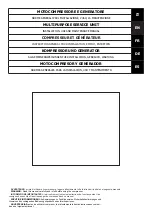
12
GENERAL MAINTENANCE (Cont'd.)
THE INTERSTAGE PRESSURE RELIEF VALVE
is provided to protect against interstage over pressure
and is factory set for maximum pressure of 75 PSIG.
DO NOT RESET
If the pressure relief valve pops, it indicates trouble. Shut down the unit immediately and determine
and correct the malfunction. Inspect the head valves. Serious damage can result if not corrected
and can lead to complete destruction of the unit. Tampering with the interstage pressure relief
valve, or plugging the opening destroys the protection provided and voids all warranty.
COMPRESSOR LUBRICATION:
Fill crankcase to proper level as indicated by oil sight gauge. Keep
crankcase filled as required by usage. It is recommended that only Champlub recip lubricant be
used. This is a 30-weight, non-detergent industrial oil with rust and oxidation inhibitors specially
formulated for reciprocating compressors. Do not mix oil types, weights or brands.
PILOT VALVE:
The pilot valve actuates the head unloader mechanism to provide a means of stopping
or starting the compression of air by the compressor without stopping or starting the electric motor.
DIESEL OR GAS ENGINE:
For service refer to separate engine manual.
COMPRESSOR PILOT VALVE PRESSURE ADJUSTMEN
T
Proceed with the following instructions while compressor is running:
1.
Loosen locknut (4) and back off several turns. Do not turn differential pressure adjustment nut (3).
2.
Check reading on the tank pressure gauge. Set the compressor maximum pressure by turning the
threaded cap (1) clockwise to increase pressure or counter clockwise to decrease pressure.
3.
After pressure is set, tighten locknut (4). Be careful not to move threaded cap (1).
COMPRESSOR PILOT VALVE DIFFERENTIAL PRESSURE ADJUSTMENT
Proceed with the following instructions while compressor is running:
1.
Loosen locknut (2) and back off several turns.
2.
Check reading on the tank pressure gauge. Set the pressure to 30 psig differential (unload at 170
psig, reload at 140 psig). Turn nut (3) clockwise to increase differential pressure or
counterclockwise to decrease differential pressure.
3.
After pressure is set, tighten locknut (2). Be careful not to move nut (3).
B980-B
(Ref. Drawing)













































